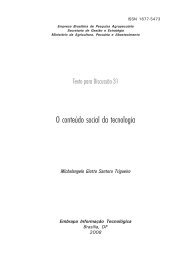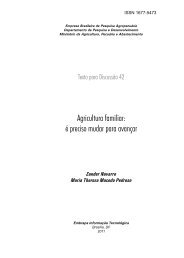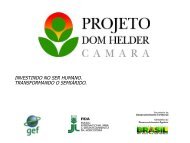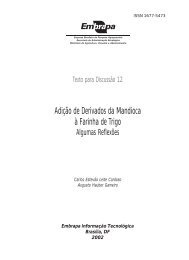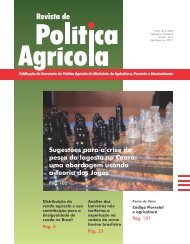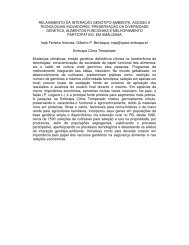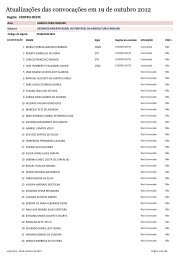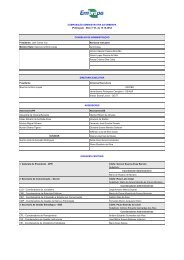Ministry of Agriculture, Livestock and Food Supply - Embrapa
Ministry of Agriculture, Livestock and Food Supply - Embrapa
Ministry of Agriculture, Livestock and Food Supply - Embrapa
Create successful ePaper yourself
Turn your PDF publications into a flip-book with our unique Google optimized e-Paper software.
in the sugar & alcohol production chain, especially in the Rankine <strong>and</strong><br />
combined cycles10 .<br />
Projections <strong>of</strong> the International Energy Agency indicate that the<br />
participation <strong>of</strong> biomass in electric power generation throughout the world will<br />
rise from 10TWh in 1995 to 27TWh by 2020.<br />
According to FAO approximately 1,333 Mt <strong>of</strong> sugarcane were produced<br />
in 1997, or 335 Mt (25%) <strong>of</strong> bagasse. One ton <strong>of</strong> bagasse with 50% humidity<br />
holds 2.85 GJ <strong>of</strong> energy.<br />
According to the National Energy Balance, the share <strong>of</strong> biomass in the<br />
Brazilian energy matrix was 27% in 2003. Energy from sugarcane bagasse<br />
was 12.6%; from firewood <strong>and</strong> charcoal, 11.9%; <strong>and</strong> from other sources,<br />
2.5%. During the 1985-1992 period cogeneration already accounted for 3.6%<br />
<strong>of</strong> the electric power produced in Brazil (WALTER, 1994).<br />
Processing sugarcane requires huge amounts <strong>of</strong> thermal, mechanical<br />
<strong>and</strong> electrical energy. Nevertheless, after the juice is extracted, it is possible<br />
to burn the sugarcane bagasse11 in boilers to produce steam, which is used<br />
to obtain three sources <strong>of</strong> energy.<br />
In addition to the bagasse, sugarcane furnishes straw <strong>and</strong> styles,<br />
which account for 55% <strong>of</strong> the energy accumulated in the sugar plantation.<br />
Although most <strong>of</strong> this energy remains in the fields, it can represent up to 30%<br />
<strong>of</strong> the total sugarcane biomass. Its maximum caloric power exceeds 15 GJ/t<br />
<strong>and</strong> its minimum caloric power is approximately 13 GJ/t. Although it could<br />
double the amount <strong>of</strong> energy obtained from sugarcane, all this potential is<br />
seldom used <strong>and</strong>, in most cases, is burned in the fields.<br />
The bagasse – 25% to 30% the weigh <strong>of</strong> the sugarcane processed –<br />
was initially, used in the sugar mills instead <strong>of</strong> firewood to generate heat.<br />
More recently, however, it has been used to generate steam, with the additional<br />
possibility <strong>of</strong> being transformed into other forms <strong>of</strong> energy, such as heat,<br />
electric power, or mechanical traction. The increased costs <strong>of</strong> electric power<br />
<strong>and</strong> petroleum have made the use <strong>of</strong> bagasse in cogeneration very attractive.<br />
10 In the Rankine cycle, a boiler is used in which a source <strong>of</strong> energy (sugarcane bagasse or straw)<br />
generates steam under high pressure at a temperature above 100ºC. The steam is released by<br />
means <strong>of</strong> mechanical systems that move machinery <strong>and</strong> transfer heat to the industrial processes or<br />
move turbines to generate electric power. The cycle is completed when the steam returns to the<br />
boiler to be heated again. In the combined cycle, a high-temperature gas turbine drives a generator<br />
<strong>and</strong> the heat <strong>of</strong> the gas is transferred to the water, generating steam. The steam moves a second<br />
generator, <strong>and</strong> both generators produce electric power.<br />
11 Understood as the macerated sugarcane stalk with 50% humidity, a residue from the crushing<br />
operation in the sugar mill.<br />
70



